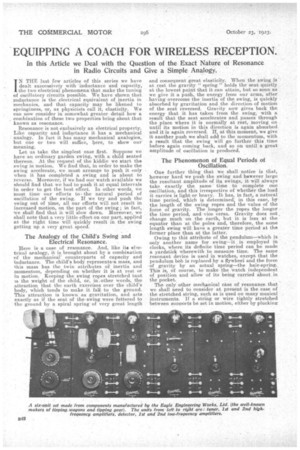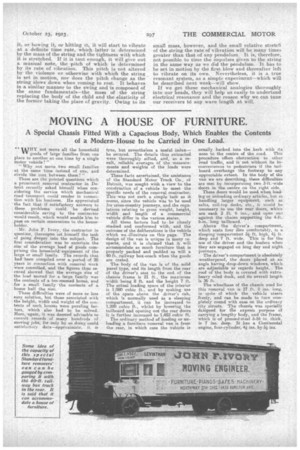EQUIPPING A COACH FOR WIRELESS RECEPTION.
Page 24

Page 25

If you've noticed an error in this article please click here to report it so we can fix it.
In this Article we Deal with the Question of the Exact Nature of Resonance in Radio Circuits and Give a Simple Analogy.
IN THE last few articles of this series we have dealt successively with 'inductance and capacity, the two electrical phenomena that make the tuning of oscillatory circuits possible. We have shown that inductance is the electrical equivalent of inertia in mechanics, and that capacity may be likened to springiness, or, as physicists call it, elasticity. We can now consider in somewhat greater detail how a combination of these two properties bring about that known as resonance.
Resonance is not exclusively an electrical property. Like capacity and inductance it has a mechanical analogy. In fact it has many mechanical analogies,. but one or two will suffice, here, to show our meaning.
Let us take the simplest case first. Suppose we have an ordinary garden swing, with a child seated thereon. At the request of the kiddie we start the swing in motion. We find that, in order to make the swing accelerate, we must arrange to push it only -when it has completed a swing and is about to reverse. Moreover, if we had our watch available we should find that we had to push it at equal intervals in order to get the best effect. In other words, xve must time our efforts to, the natural period of oscillation of the swing. If we try and push the swing out of time, all our efforts will not result in increased motion, on the part of the swing ; in fact, we shall find that it will slow down. Moreover, we shall note that a very little effort on our part, applied at the right time will quickly result in the swing getting up a very great speed.
The Analogy of the Child's Swing and Electrical Resonance.
Here is a case of resonance. And, like its electrical analogy, it is brought about by a combination of the mechanical counterparts of capacity and inductance. The child's body represents‘a mass, and this mass has the twin attributes 61 inertia and momentum, depending on whether it is at rest or in motion. Keeping the swing ropes stretched taut is the weight of the child, Or, in, other words, the attraction that the earth exercises over the child's body, which tends to make it fall to the ground. This attraction is known as gravitation, and acts exactly as if the seat of the swing were fettered to the ground by a spiral spring' of very great length
and consequent great elasticity. When the swing is at rest the gravity " spring" holds the-seat quietly at the lowest point that it can attain, but so soon as we give it a push, the energy from our arms, after having overcome the inertia of the swing, is quickly absorbed by gravitation and the direction of motion of the seat reversed. Gravity now gives back the. energy that it has taken from the swing, with a result that the seat accelerates and passes through the place where it is normally at rest, moving on until its motion in this direction is again absorbed and it is again reversed. If, at this moment, we give it another push we shall add to the momentum, with a result that the swing will go further this time before again coming back, and so on until a great amplitude of oscillation is produced.
The Phenomenon of Equal Periods of Oscillation.
One further thing that we shall notice is that, however hard we push the swing and hewever large the resultant amplitude of its swings, it will always take exactly the same time to complete one oscillation, and this irrespective of whether the load it carries is light or heavy. It has, in fact, a natural time period, which is determined,' in this case., by the length of the swing ropes and the value of the force of gravity. The longer the ropes the longer the time period, and vice versa. Gravity does not, change much on the earth, but it is less at the equator than at the poles and, therefore, the same length swing will have a greater time period at the former place than at the latter. Owing to thiS attribute of the pendulum—which is only another name for swing—it is employed in clocks, whom its definite time period can be made a yardstick wherewith to measure time. The same resonant device is used in watches, except that the pendulum bob is replaced by a flywheel and the force of gravity by an actual spring—the hair-spring. This is, of course, to make the watch independent of position and allow of its being carried about in the pocket.
The only other mechanical case of resonance that we shall need to consider at present is the case of the stretched string, such as is used on many musical instruments. If a string or wire tightly stretched between supports be set in motion, either by plucking it, or bowing it, or hitting it, it will start to vibrate at a definite time rate, which latter is determined by the mass of the string and the tightness with which it is stretched. If it is taut enough, it will give out a musical note, the pitch of which is determined by its rate of vibration. This pitch is not altered by the violence or otherwise with which the string is set in motion, nor does the pitch change as the string slows down when coming to rest. It behaves in a similar manner to the swing and is composed of the same fundamentals—the mass of the string replacing the body of the child and the elasticity of the former taking the place of gravity. Owing to its small mass, however, and the small relative stretch of the string the rate of vibration will be many times greater than that of any pendulum. It is, therefore, not possible to time the impulses given to the string in the same way as we did the pendulum. It has to be set in motion by the first blow and thereafter left to vibrate on its own. Nevertheless, it is a true resonant system, as a simple experiment—which will be described next week—will show.
If we get these mechanical analogies thoroughly into our heads, they will help us easily to undertand electrical resonance and the reason why we can tune our receivers td any wave length at will.






























